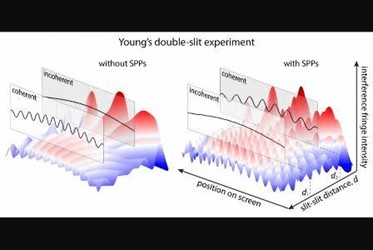Modified Double-Slit Experiment Achieves Widest Degree Of Optical Spatial Coherence
By Jof Enriquez,
Follow me on Twitter @jofenriq

Researchers at Brown University have demonstrated a new method of modulating the coherence of light by using surface plasmon polaritons in metal films. This technique represents an alternative way to engineer flat optical elements that could be applied in optical communication, beam shaping, and microscopic imaging.
“Coherence, like color and polarization, is a fundamental property of light,” said Domenico Pacifici, an associate professor of engineering and physics at Brown and co-author of the research. “We have filters that can manipulate the color of light and we have things like polarizing sunglasses that can manipulate polarization. The goal with this work was to find a way to manipulate coherence like we can these other properties.”
Previously, other researchers have demonstrated that it is possible to control coherence, albeit to a limited degree. Modulating coherence in the micrometer scale has proved especially challenging.
Dongfang Li, a postdoctoral researcher in Brown’s School of Engineering and the study’s lead author, says their work “is the first time very strong modulation of coherence has been realized experimentally.”
Traditionally, coherence is measured, but not altered, by a classic double-slit experiment devised by the English scientist Thomas Young in 1801 that first inferred the wave-like nature of light. In his experiment, two narrow parallel slits are cut into a thin sheet of metal, which is illuminated by a coherent light source. When light passes through the slits, they project an interference pattern on a screen placed some distance behind the metal sheet. The pattern consisting of light and dark bands is made possible only if light is a wave (and not a classical particle alone).
Li and Pacifici modified Young's experiment to not only measure, but also control, the coherence of light using ripples of electron density called surface plasmon polaritons placed on both surfaces of the thin metal film through nanofabrication methods.
“We use surface plasmon polaritons—evanescent waves excited on both surfaces of a thin metal film—as a means to mix the random fluctuations of the incident electromagnetic fields at the slit locations of a Young’s double-slit interferometer,” they wrote in Science Advances.
“The surface plasmon polaritons open up a channel for the light at each slit to talk to each other,” Li said. “By connecting the two, we’re able to change the mutual correlations between them and therefore change the coherence of light.”
The research duo from Brown claims to have modulated coherence across a range from 0 percent (totally incoherent) to 80 percent (nearly full coherent), an unprecedented level of modulation never before achieved. By changing the type of light source and the distance between slits, they say they were able to transform totally incoherent incident light into highly coherent light, and vice versa.
“We’ve broken a barrier in showing that it’s possible to do this,” Pacifici said. “This clears the way for new two-dimensional beam shapers, filters and lenses that can manipulate entire optical beams by using the coherence of light as a powerful tuning knob.”
